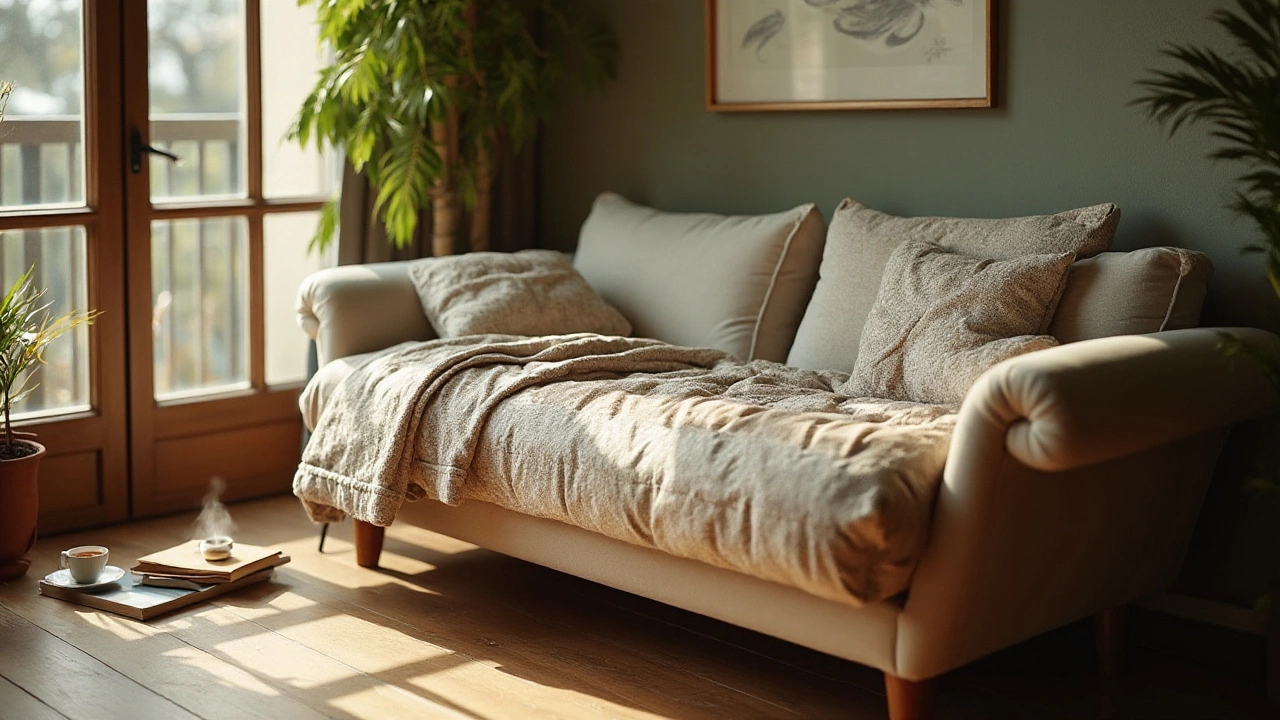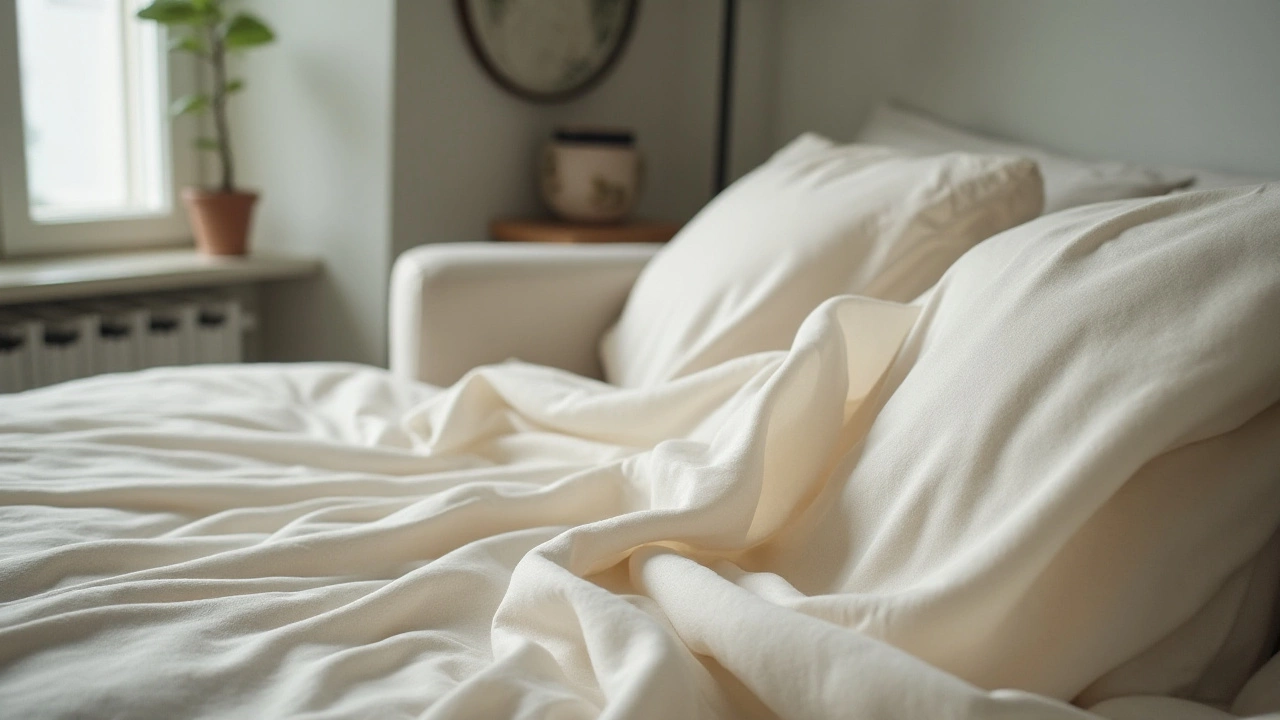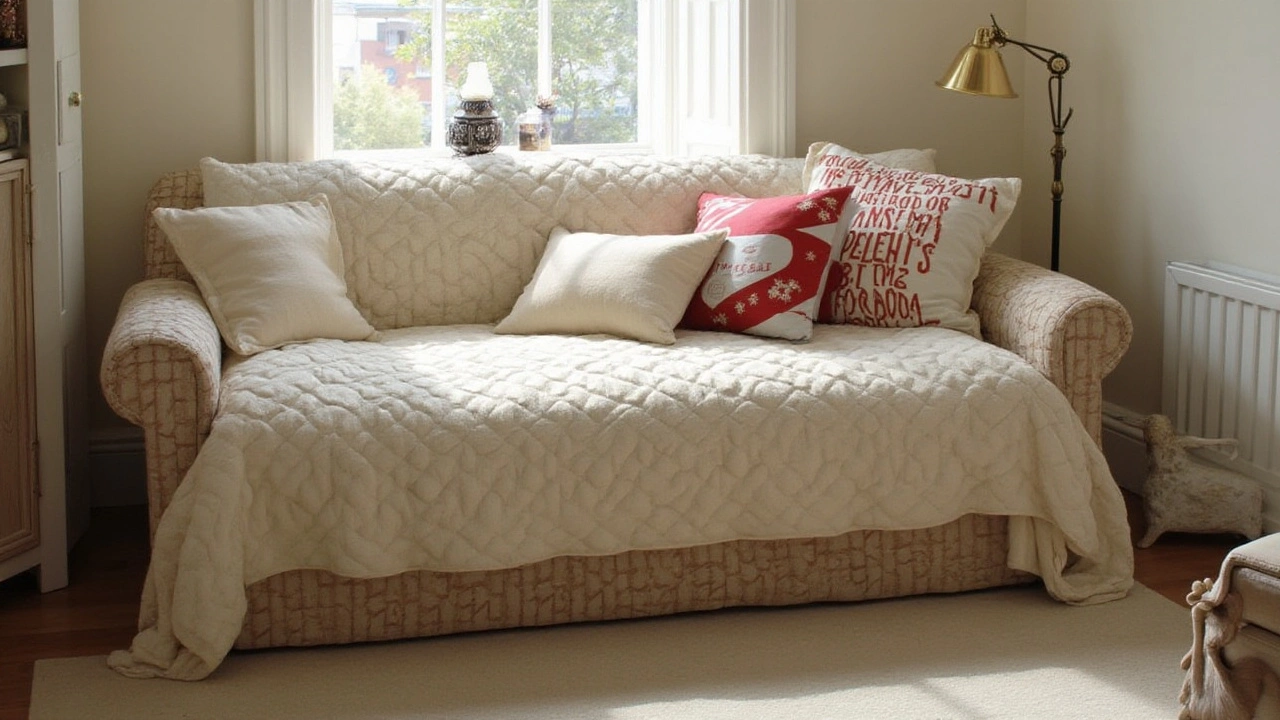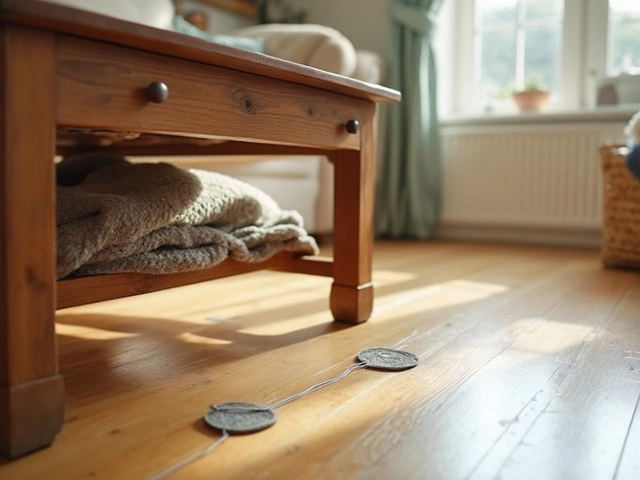 7
Jan,2025
7
Jan,2025
Ever nestled into a pile of blankets and thought, there's got to be a better way to do this? Enter the kakebuton, a delightful slice of Japanese tradition that's making waves in the world of home comfort. If you've ever laid awake pondering the perfect addition to your sofa bed, you're in the right place.
Picture this: a lightweight, yet snug layer that’s just what you need for a restful night. The kakebuton is more than just a blanket; it’s a piece of adaptable, cultural artistry that transforms ordinary sofa beds into cozy havens.
Whether you're navigating the world of bedding for the first time or you simply have a curiosity for traditional yet practical household items, join us on this enlightening journey through the soft texture and gentle warmth of kakebutons. Your living room will thank you!
- Understanding the Kakebuton
- Cultural Significance of Kakebutons
- Choosing the Right Kakebuton
- Benefits for Sofa Beds
- Caring for Your Kakebuton
- Incorporating Kakebutons in Modern Decor
Understanding the Kakebuton
In the intricate realm of bedding, the kakebuton has carved a niche of its own. Originating from Japan, this staple of comfort and warmth has sustained its legendary reputation for centuries. The term 'kakebuton' itself is rooted in the Japanese language, where 'kake' means to cover and 'futon' refers to the bedding itself. Traditionally, a kakebuton is a thick quilted pad, often stuffed with cotton or down, serving as a blanket. Unlike its Western counterparts, what sets it apart is its lightness blended with warmth, making it an ideal choice for both chilly winter nights and the mildness of spring.
One cannot underestimate the meticulous craftsmanship that goes into creating a kakebuton. These quilts are often crafted with beautiful, intricate designs that reflect Japan's cultural heritage. The soft filling is encased in a finely woven cotton shell, often adorned with calming colors or elegant patterns. The intent is to not only ensure warmth and comfort but also offer aesthetic pleasure. They are used as a comforting layer on sofa beds, redefining them from mere furniture to sleeping sanctuaries. Interestingly, the design of the kakebuton encourages air circulation, ensuring it is breathable yet cozy.
As the world embraces minimalistic and sustainable living, the kakebuton becomes even more relevant. It is a testament to traditional Japanese values where simplicity meets functionality. While Western culture often favors bulk and plushiness, the Japanese approach highlights balance and substance. This blend allows the kakebuton to fit seamlessly into contemporary home decor, offering a touch of elegance and practicality. With a growing trend towards multifunctional living spaces, the kakebuton facilitates the transition of a living room sofa into a restful bed with unparalleled ease.
The New York Times noted, "As the world grows smaller, age-old traditions like the kakebuton are finding their place in modern homes, appreciated for their utility and understated beauty."
This revered piece of bedding isn't just about function. It's an invitation to experience a slice of Japanese lifestyle right in the comfort of your home. With advancements in textile technology, modern kakebutons can be filled with hypoallergenic materials, adding an extra layer of appeal for those conscious of health benefits. Whether one is immersing in deep slumber or indulging in a lazy afternoon on a sofa bed, the kakebuton promises an experience that's both comforting and delightful.
Cultural Significance of Kakebutons
The kakebuton holds a cherished place in Japanese culture, where the art of sleeping is steeped in tradition. Emerging from historical customs, its roots extend to the era of futon bedding, a staple in Japanese households. These flat, quilted sleeping arrangements have been pivotal in a culture that values space efficiency and minimalism. Unlike the western interpretations of linen and blankets, the kakebuton represents a thoughtful integration of warmth and comfort in a singular piece, adapted perfectly to the flexibility of Japanese interiors.
In Japan, a society known for its aesthetic simplicity and functionality, the kakebuton is more than just bedding; it's a cultural artifact. Its use has been associated with the practice of ‘mono no aware’ – the appreciation of transient beauty. The changing of seasons in Japan, notably from the colorful autumn to the chilly winter, emphasizes the need for a bedding transformation, with the kakebuton providing both comfort and visual pleasure. The cyclical nature of bedding aligns with wider Japanese philosophies of seasonality and harmony with nature.
A traditional Japanese saying expresses this sentiment well: "Living in harmony with the seasons allows us to live in harmony with life," reminding us of the kakebuton's role in embodying this balance.
This legacy of warmth and elegance transcends mere utility. The meticulous craftsmanship involved in creating a kakebuton reflects the Japanese dedication to ‘shokunin,’ or artisan spirit. Every stitch and layer exemplifies attention to detail and reverence for tradition. Manufacturers in Japan often employ age-old techniques, ensuring each piece is of the highest quality—a tangible connection to historic craftsmanship that modern productions are keen to emulate.
Today, the global spread of Japanese culture has introduced the kakebuton to diverse populations. As homes in the West embrace eastern philosophies in living spaces, the kakebuton has traveled beyond its native shores, seamlessly blending into varied decor styles. Its appeal lies in its profound versatility—whether as a warm addition to sofa beds or an artistic drape over a couch, the kakebuton serves as a bridge between cultures, offering both function and an invitation to explore a rich heritage. In this way, owning a kakebuton is more than an enhancement to one's home; it's an entry point into a lifestyle that celebrates both the utility and beauty found in every fold and fiber.

Choosing the Right Kakebuton
Embarking on the journey to find the perfect kakebuton can transform your sleeping experience from ordinary to extraordinary. Much like an artist choosing the right brush, selecting the right kakebuton involves careful consideration of several factors. From the material to the size and fill type, each aspect plays a crucial role in ensuring comfort and warmth. When you're out shopping, pay close attention to the fabric of the kakebuton. Traditional ones are often crafted from cotton, which offers breathability and softness. However, if luxury is what you seek, silk options provide a smooth, alluring finish that's hard to resist. Wool is another great option for those who desire natural insulation properties, perfect for those chilly Melbourne nights.
Size is another key factor. A kakebuton that's too small won't provide adequate coverage, leaving parts of the sofa bed exposed and uncomfortably cold. Conversely, one that's too large may overwhelm the sofa bed, making it cumbersome to handle. A good rule of thumb is to measure your sofa bed first. Look for kakebutons that are just slightly larger, ensuring a snug fit without excess overhang. Fill type, often overlooked, is crucial to the comfort level. Down filling tends to offer a plush, cloud-like feel, while synthetic alternatives provide allergy-friendly options without sacrificing comfort. Care instructions should also play a part in your decision-making process, especially if you're keen on keeping maintenance efforts to a minimum. Some kakebutons can be machine-washed, while others might require professional cleaning services.
It's not just about personal preference; consider the decor of your home. Ideally, your choice of kakebuton should harmonize with your existing color palette and interior design. Opt for neutral shades if you want a timeless look, or choose bold colors or patterns to make a statement. According to interior design expert Ichiro Tanaka, "A kakebuton is more than just bedding—it's a reflection of your personal taste and an integral part of your home's aesthetic."
If you're looking for a balance between tradition and modernity, keep your eyes peeled for hybrid kakebutons that blend traditional Japanese craftsmanship with modern materials and styles. These often feature innovative designs that cater specifically to the multi-functional purpose of sofa beds. Some may even come with reversible designs, offering two different looks and textures in one item. Price, of course, is always top of mind. While there are budget-friendly options available, investing in a high-quality kakebuton can be rewarding in the long run. Not only do they last longer, but they often deliver on comfort more effectively.
Should you be inclined to delve deeper into what makes a kakebuton unique, a quick comparison might shed some light. Consider the following data that show the average price range and lifespan of different materials:
| Material | Average Price Range (AUD) | Average Lifespan (Years) |
|---|---|---|
| Cotton | $50-$200 | 5-7 |
| Silk | $150-$500 | 10+ |
| Wool | $100-$300 | 7-10 |
| Synthetic | $30-$150 | 3-5 |
Choosing a kakebuton is not just about the immediate comfort but also about making a long-term investment in your home and well-being. Armed with these insights, you'll be well on your way to finding a piece that's perfectly suited to your sofa bed and aesthetic preferences, paving the way to countless restful nights.
Benefits for Sofa Beds
For those who have embraced the multifunctionality of sofa beds, the discovery of the kakebuton is a game-changer. Often, balancing comfort and practicality when it comes to transforming a sofa into a bed is a challenge. The kakebuton helps bridge this gap with its lightweight yet warm design, ensuring that guests or the occasional sleeper don’t compromise on the quality of rest.
The kakebuton's unique quilted structure provides an efficient way to maintain heat, making it perfect for situations where you need that extra layer without the bulk. Imagine evenings where guests decide to stay the night or when you seek a cozy refuge for those impromptu weekend snoozes. A kakebuton effortlessly conforms to your sofa’s form, maximizing the existing space without overwhelming it. This tailored flexibility is not just about coverage, but also a commitment to coziness that heavier option rarely provide.
There's an inherent value in owning a piece of furniture or decor that resonates with cultural significance while catering to modern needs. The kakebuton does precisely that — it's steeped in Japanese tradition, where space-saving solutions that don’t sacrifice comfort are paramount. According to a recent survey by Global Home Decorating Trends, interest in traditional Japanese bedding, like kakebutons, for sofa use has increased by 40% over the past few years. This trend is attributed to the global shift towards minimalist living and the pursuit of multifunctional spaces.
The Interior Designers Guild highlights: “Incorporating elements like the kakebuton gives you an edge in making your living space both functional and inviting. It’s a small shift that brings big comfort—especially in hybrid spaces.”
Moreover, considering that kakebutons are typically made from breathable materials like cotton or a cotton-polyester blend, they not only ensure warmth but also improve air circulation. This means no need to worry about waking up in a clammy fog of mystery — everyone’s worst nightmare come morning. And let’s not forget the ease of maintenance. Most kakebutons are machine washable, meaning you can keep that fresh comfort around without hassle. It’s these small conveniences that elevate the sleepy corner of your living room into an inviting oasis.

Caring for Your Kakebuton
So, you've decided to bring the cozy charm of a kakebuton into your home, and now you're wondering how to keep it as inviting as the day it arrived. The good news is, caring for a kakebuton is a delightful mix of tradition and practical know-how. Unlike heavier duvets or comforters that might require specialized cleaning, kakebutons are lauded for their manageability. Proper care begins with understanding its materials. These are primarily made from breathable cotton or a lightweight polyester that often envelopes a soft wadding. The fabric's quality not only provides comfort but also helps maintain the balance needed between warmth and airiness. Regular airing of your kakebuton is key, especially on sunny days. This time-honored practice freshens it up, expands its fibers, and even reduces moisture buildup, which is crucial in climates with more humidity.
Washing is another important aspect to consider. For a kakebuton, gentle is the keyword. Machine washing is possible, but it's best done with precaution. Use cold water and a mild detergent to retain the vibrancy and softness of the material. Given its delicacy, a cycle resembling that of a cloud's embrace—soft and gentle—aims to preserve it. If your washing machine comes with a delicate cycle option, it’s worth using. This maintains the inner fill's volume while ensuring that the surface remains smooth to the touch. Drying a kakebuton is ideally done outdoors on a clothesline or flat on a clean surface, allowing gravity to work its magic while keeping away from direct, harsh sunlight which could affect its color.
As you partake in the care of your kakebuton, consider the words of renowned Japanese designer Nendo, 'Design is not for philosophy, it's for life.' This reminds us that integrating a kakebuton into your lifestyle includes making thoughtful choices that extend its lifespan.
What about those pesky stains that life inevitably brings? Spot cleaning is your friend here. A bit of cold water, mixed with a touch of gentle soap, can be your ally. Dab, don't rub, to prevent pushing the stain deeper into the fabric. Consistency and delicacy in this process are valuable allies. Also, flipping your kakebuton regularly can prevent uneven wear, keeping it fresh on both sides. More than just maintenance, it reinforces the cultural essence of appreciation for each thread's craftsmanship. Embrace these small rituals with the attention they deserve, as they ensure your kakebuton remains a staple of comfort in your home.
Storage is the last, yet equally crucial point in caring for a kakebuton. When it’s time to store it away, perhaps during humid summers, opt for breathable storage bags. This allows for air circulation while keeping it safe from dust. Vacuum packing might be tempting but remember, it compresses the fibers, which are then cumbersome to fluff back to their original splendor. For families or shared spaces, label storage is useful—imagine each future season as a treasure hunt, where opening a bag gives the nostalgic scent of coziness crafted months prior. Through these mindful practices, your kakebuton remains not just a practical body of warmth, but a piece of cultural legacy cherished year after year.
Incorporating Kakebutons in Modern Decor
The kakebuton isn't just a relic of traditional Japanese homes; it's a versatile piece of decor that can seamlessly fit into contemporary settings. Nowadays, blending traditional elements with modern design is considered quite trendy. By incorporating a kakebuton into your living space, you create a unique fusion that adds both aesthetic and functional value to your home. Imagine a minimalist living room where clean lines and neutral colors dominate. A kakebuton can stand out or blend in depending on the fabric and color scheme you choose. Opt for one with a bold pattern to make the kakebuton the focal point, or pick subtle shades to complement existing decor without overpowering the space.
Consider the kakebuton as an artistic statement. This item isn't merely for utilitarian purposes; it allows you to express eclectic tastes. You can drape it over a sofa bed by day, showcasing its intricate designs, then simply fold it into a cozy sleeping companion by night. Emphasizing its cultural origin, one might say, "The kakebuton brings tranquility and simplicity to our chaotic lives," a sentiment echoed by many who have embraced this item.
In a world where sustainability is increasingly emphasized, kakebutons offer an eco-friendly option for decor. Often made from natural materials like cotton or silk, they appeal to those looking to lessen their environmental impact. This is an effortless way to incorporate ethically made products into your home setting. Besides, the sofa beds equipped with a kakebuton become dual-purpose, optimizing space — ideal for urban residents where every inch matters.
When decorating with a kakebuton, think about layers. Use the kakebuton as part of a layering strategy that includes other textures and fabrics like wool throws and linen cushions. This approach can create depth and warmth in your room, adding a tactile quality to the visual appeal. Japanese bedding is typically part of a system, so integrating it in similar philosophies can complement modern layouts wonderfully.
Don’t underestimate the transformative power of a kakebuton. It has a way of turning the ordinary into extraordinary by simply being part of the setting. In conclusion, the kakebuton is a passport into a more intentional, serene living environment, proving that sometimes it’s the simplest updates that deliver the most impact. As more people discover the joys of merging this traditional piece into their contemporary abodes, the rise of kakebutons in modern decor seems inevitable.




